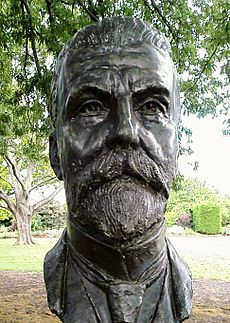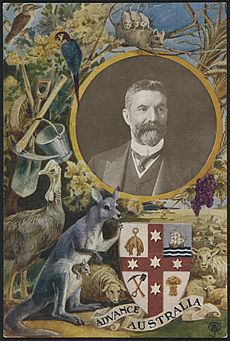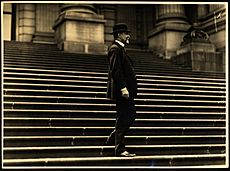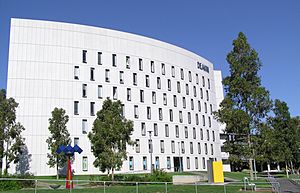Alfred Deakin facts for kids
Quick facts for kids
Alfred Deakin
|
|||||||||||||||||||||||||||||||||||
|---|---|---|---|---|---|---|---|---|---|---|---|---|---|---|---|---|---|---|---|---|---|---|---|---|---|---|---|---|---|---|---|---|---|---|---|

Deakin in 1905
|
|||||||||||||||||||||||||||||||||||
| 2nd Prime Minister of Australia | |||||||||||||||||||||||||||||||||||
| In office 2 June 1909 – 29 April 1910 |
|||||||||||||||||||||||||||||||||||
| Monarch | Edward VII | ||||||||||||||||||||||||||||||||||
| Governor-General | Lord Dudley | ||||||||||||||||||||||||||||||||||
| Preceded by | Andrew Fisher | ||||||||||||||||||||||||||||||||||
| Succeeded by | Andrew Fisher | ||||||||||||||||||||||||||||||||||
| In office 5 July 1905 – 13 November 1908 |
|||||||||||||||||||||||||||||||||||
| Monarch | Edward VII | ||||||||||||||||||||||||||||||||||
| Governor-General | Lord Northcote Lord Dudley |
||||||||||||||||||||||||||||||||||
| Preceded by | George Reid | ||||||||||||||||||||||||||||||||||
| Succeeded by | Andrew Fisher | ||||||||||||||||||||||||||||||||||
| In office 24 September 1903 – 27 April 1904 |
|||||||||||||||||||||||||||||||||||
| Monarch | Edward VII | ||||||||||||||||||||||||||||||||||
| Governor-General | Lord Tennyson Lord Northcote |
||||||||||||||||||||||||||||||||||
| Preceded by | Edmund Barton | ||||||||||||||||||||||||||||||||||
| Succeeded by | Chris Watson | ||||||||||||||||||||||||||||||||||
| Leader of the Opposition | |||||||||||||||||||||||||||||||||||
| In office 1 July 1910 – 20 January 1913 |
|||||||||||||||||||||||||||||||||||
| Prime Minister | Andrew Fisher | ||||||||||||||||||||||||||||||||||
| Preceded by | Andrew Fisher | ||||||||||||||||||||||||||||||||||
| Succeeded by | Joseph Cook | ||||||||||||||||||||||||||||||||||
| In office 26 May 1909 – 2 June 1909 |
|||||||||||||||||||||||||||||||||||
| Prime Minister | Andrew Fisher | ||||||||||||||||||||||||||||||||||
| Preceded by | Joseph Cook | ||||||||||||||||||||||||||||||||||
| Succeeded by | Andrew Fisher | ||||||||||||||||||||||||||||||||||
|
|||||||||||||||||||||||||||||||||||
|
|||||||||||||||||||||||||||||||||||
|
|||||||||||||||||||||||||||||||||||
| Personal details | |||||||||||||||||||||||||||||||||||
| Born | 3 August 1856 Fitzroy, Colony of Victoria |
||||||||||||||||||||||||||||||||||
| Died | 7 October 1919 (aged 63) South Yarra, Victoria, Australia |
||||||||||||||||||||||||||||||||||
| Resting place | St Kilda Cemetery | ||||||||||||||||||||||||||||||||||
| Political party | Independent (until 1901) Protectionist (1901–1909) Liberal (after 1909) |
||||||||||||||||||||||||||||||||||
| Spouses |
Pattie Browne
(m. 1882) |
||||||||||||||||||||||||||||||||||
| Children | 3, including Ivy and Vera | ||||||||||||||||||||||||||||||||||
| Relatives | Wilfred Brookes (grandson) Alfred Brookes (grandson) Rohan Deakin Rivett (grandson) |
||||||||||||||||||||||||||||||||||
| Education | Melbourne Grammar School University of Melbourne (no degree) |
||||||||||||||||||||||||||||||||||
| Occupation | Barrister | ||||||||||||||||||||||||||||||||||
| Signature | |||||||||||||||||||||||||||||||||||
Alfred Deakin (born 3 August 1856 – died 7 October 1919) was an important Australian politician. He served as the second Prime Minister of Australia. He was a key leader in the movement to unite the Australian colonies into one country, known as Federation, which happened in 1901.
During his three times as prime minister (1903–1904, 1905–1908, 1909–1910), he helped create many important national organisations and laws. Deakin was born in Melbourne to middle-class parents. He became a member of the Victorian Parliament in 1879 at age 23. He also worked as a lawyer and journalist.
In the 1890s, Deakin became a leading figure in the push for Federation. He helped write the new Australian constitution. He also campaigned for people to vote for it and convinced the British government to approve it.
After Federation in 1901, Deakin became the first Attorney-General of Australia in the government led by his friend Edmund Barton. Deakin took over as prime minister in September 1903. His party, the Liberal Protectionists, often held the middle ground between the other two main parties.
He left office in April 1904 but returned in July 1905. He formed a working government with support from the Australian Labor Party (ALP). He left office again in August 1908.
In 1909, Deakin led his supporters to join with another party, forming the Fusion. This was a big step that helped create the two-party system in Australian politics. His final term as prime minister (June 1909 to April 1910) was very productive. However, the ALP won a majority in the 1910 election, which surprised him. He retired from politics in 1913 due to a health condition.
Deakin is remembered as one of Australia's most important prime ministers. He helped shape many of Australia's early policies. These included the White Australia policy (which limited non-European immigration), compulsory arbitration (a system for solving worker disputes), and protectionism (supporting local industries).
Contents
Early Life and Education
Growing Up in Victoria
Alfred Deakin was born on 3 August 1856 in Fitzroy, a suburb of Melbourne. His parents, Sarah and William Deakin, had moved to Australia from Britain in 1850. His father worked in transport, helping to move people and goods. This job allowed his family to live a comfortable middle-class life.
Deakin spent his early years in Fitzroy and then South Yarra. When he was four, he went to a boarding school in Kyneton with his older sister. He was the only boy there. Later, he attended Melbourne Grammar School for eight years. He was a good student but wished he had worked harder. He also loved playing Australian rules football.
Becoming a Lawyer and Writer
In 1871, at age 15, Deakin passed the exam to enter the University of Melbourne. He wanted to become a lawyer. He studied at night while working as a teacher during the day. He became a lawyer in 1877, even though he didn't finish a full university degree.
While at university, Deakin was very active in the debating society. He spent much of his free time reading many different books. For a while, he dreamed of being a writer, poet, or philosopher. In 1875, he even published a play called Quentin Massys.
In 1878, Deakin met David Syme, the owner of The Age newspaper. Syme hired him to write articles about politics and literature. Deakin also became editor of The Leader, a weekly paper. Syme convinced him to support "protectionism," which meant supporting local industries with tariffs. Deakin also became a lifelong spiritualist.
Early Political Career
In 1879, Deakin ran for a seat in the Victorian Parliament. He supported changes to the law, protecting local businesses, and a land tax. He won his seat but resigned because some people couldn't vote. He lost the next election but won again in July 1880.
In 1882, Deakin married Elizabeth Martha Anne ("Pattie") Browne. They had three daughters: Ivy, Stella, and Vera.
Deakin became a government minister in 1883. He worked on public works and water supply. In 1885, he helped pass a law to improve working conditions and hours in factories and shops. He also travelled to the United States to study irrigation and later helped create laws to manage water rights in Victoria.
In 1887, Deakin led Victoria's group to a big meeting in London. He argued for Australia to pay less for defence from the British Navy. He also wanted better discussions about the New Hebrides islands.
The government he was part of fell in 1890. Deakin also lost his money in a property crash in 1893. He had to return to working as a lawyer to earn money again.
The Road to Federation
After 1890, Deakin focused on the movement to unite the Australian colonies. He was a key representative for Victoria at the meetings that created the first draft of the Australian constitution. This draft became much of the Constitution of Australia we have today.
Deakin worked hard to bring different groups together and solve difficult problems during these meetings. He travelled around the country, speaking to people and helping them understand why Federation was important. His efforts helped Victoria vote strongly in favour of Federation.
In 1900, Deakin went to London with Edmund Barton and Charles Kingston. Their job was to make sure the British Parliament passed the law for Federation. They had to negotiate with the British Colonial Secretary, Joseph Chamberlain. They reached a compromise about how appeals from Australia's highest court would work.
Deakin saw himself as an "independent Australian Briton." He wanted Australia to govern itself but still be loyal to the British Empire. He believed that uniting the empire could lead to greater world unity.
Australia's First Attorney-General

In 1901, Deakin was elected to the first federal Parliament for the Division of Ballaarat. He became the first Attorney-General of Australia in the government led by Edmund Barton. He helped write important laws for the public service, worker disputes, and the High Court.
He also spoke in favour of the White Australia policy, which aimed to limit non-European immigration. He believed this policy was needed to protect Australian workers.
Deakin almost resigned in 1902 because he disagreed with a proposed pay rise for politicians. But Barton convinced him to stay. When Barton went to England in 1902, Deakin became the Acting Prime Minister. He handled important issues like the Governor-General's resignation and a dispute with South Australia.
In 1903, Deakin helped pass the Judiciary Act 1903, which created the High Court of Australia. He also worked on a bill for solving industrial disputes, but it was later withdrawn.
Prime Minister, 1903–1904
After the High Court was set up, Edmund Barton decided to become a judge. Deakin was the clear choice to take over as prime minister. He was sworn in on 24 September 1903.
The 1903 Election
A month after becoming prime minister, Deakin called an early election in December 1903. He hoped to surprise his opponents and benefit from women being able to vote for the first time.
Deakin campaigned on "fiscal peace and preferential trade for a White Australia." "Fiscal peace" meant ending arguments about tariffs. "Preferential trade" meant closer trade ties with Britain. The election resulted in three main parties, with Deakin's Liberal Protectionists in the middle.
Deakin believed it was important for the three parties to become two. He saw his party as a bridge between the others.
Leaving Office
Deakin tried to work with the Labor Party after the election, but it was difficult. In March 1904, he introduced a bill to help solve worker disputes. However, he didn't include state public servants, which Labor wanted.
On 22 April, a Labor politician, Andrew Fisher, proposed an amendment to include state public servants. The amendment passed, and Deakin saw this as a sign that his government no longer had enough support. He resigned as prime minister on the same day.
Some people think Deakin resigned to show that the Labor Party wasn't ready to govern. But his diaries suggest he was also very stressed and might have wanted to leave office.
Out of Office
Deakin promised to be fair to the new Watson Government, led by Chris Watson of the Labor Party. His own party was split between those who wanted to work with Labor and those who wanted to work with the Free Traders.
Deakin tried to make an agreement with the Free Traders, but his party rejected it. He felt that Labor's strict party rules would weaken his Protectionist party. He explained his views in a speech, saying he was caught between conservatives and Labor's focus on material things.
The Watson Government fell less than two weeks after Deakin's speech. Many Labor members felt Deakin had betrayed them. Billy Hughes accused him of being a hypocrite. Deakin responded with strong personal attacks but later apologised.
Deakin chose not to join the new government led by George Reid (a Free Trader). He supported it from the sidelines. He also seriously thought about leaving politics during this time. He wrote articles for newspapers and spent time on his religious interests. He even met Salvation Army founder William Booth.
"Notice to Quit"
In 1905, Deakin's supporters urged him to return to government. He felt re-energised after a trip to Western Australia. Chris Watson also privately told him that Labor would support him if he became prime minister again.
On 24 June 1905, Deakin gave a speech in Ballarat. He criticised both Labor and the Free Traders. The Age newspaper then published an editorial saying Deakin's speech was a "notice to Mr Reid to quit." This meant Deakin was challenging Reid for the prime minister role.
Deakin denied this, but Reid took it that way. Deakin then successfully moved a motion that showed his government no longer had support. Reid asked the Governor-General for an early election, but was refused. Deakin was then asked to form a new government.
Prime Minister, 1905–1908
Deakin became prime minister again in mid-1905. This was his longest and most successful time in office. His government passed many important laws that shaped Australia in its early years.
New Laws and Policies
- Australian Currency: Laws were passed to create Australia's own money.
- New Government Agencies: The Commonwealth Bureau of Census and Statistics was set up in 1906, and the Commonwealth Bureau of Meteorology in 1908.
- Protection for Industries: The Australian Industries Protection Act was passed. This law tried to make sure companies paid fair wages if they received government help.
- High Court: In 1906, the High Court was expanded to five judges, as planned in the constitution.
- Papua: The Papua Act of 1905 set up an Australian administration for what was then British New Guinea.
- Northern Territory: His government passed a bill to transfer control of the Northern Territory from South Australia to the Commonwealth.
- Capital City: Deakin strongly supported the idea of the capital city being in Dalgety, but it was later moved to the Canberra area.
Defence and Foreign Affairs
Deakin also focused on Australia's defence. In 1907, he introduced a bill for compulsory military service for young men. He had long wanted Australia to have its own navy instead of relying on the British Navy.
In 1906, he announced Australia would buy its own destroyers. In 1908, he invited Theodore Roosevelt's Great White Fleet (a group of US Navy ships) to visit Australia. This was a symbolic act to show Australia's growing independence from Britain. Funds were set aside for a navy, which later became the first independent navy in the British Empire under the Labor government.
The Fusion
In 1908, the Labor Party again forced Deakin out of office. He then made a big decision: he formed a new political group called the "Fusion" with his old rival, George Reid. This alliance brought him back to power in May 1909.
This "Fusion" was controversial. Many people saw it as Deakin abandoning his earlier principles. Some, like Sir William Lyne, even called him a "Judas." However, it created Australia's first majority government.
Prime Minister, 1909–1910
Deakin became prime minister for the third time on 2 June 1909. His new government included members from both sides of the Fusion.
In 1909, many important laws were passed:
- Australian Coinage: Laws allowed for the creation of separate Australian coins.
- Military Training: Compulsory military training for young men was introduced.
- Capital Territory: The boundaries of the future Australian Capital Territory were defined.
- High Commissioner: The office of the Australian High Commissioner to the United Kingdom was created. This was Australia's first official diplomat overseas.
Deakin also worked with state governments to create the Financial Agreement of 1909. This agreement decided how federal money would be shared with the states. He saw this as one of his most important achievements.
Final Defeat
Deakin did not call an early election. He expected to win easily in the April 1910 federal election. This election was the first time voters had a clear choice between two main parties.
To Deakin's surprise, the Labor Party won a clear majority. Many of his former supporters voted against him because of the Fusion. Deakin himself won his seat by only a few hundred votes. He called it the "Waterloo of the Liberal Party."
Leader of the Opposition, 1910–1913
After the 1910 election, Deakin had less power as the leader of the opposition. Labor had majorities in both houses of parliament. His diaries show he wanted to resign, but he stayed on because there was no clear successor.
He led the campaign against the Labor government's proposed changes to the constitution in 1911. These changes would have given the federal government much more power. Deakin campaigned for two months, visiting almost every state. The "No" vote won, which was a big success for the opposition.
By 1912, Deakin was tired of public life. He gave his final speech to parliament on 18 December 1912. He announced his retirement on 8 January 1913. He helped choose Joseph Cook as his successor. Deakin left parliament at the 1913 federal election.
Later Years and Legacy
After leaving politics, Deakin was offered a position as chairman of the Interstate Commission, but he declined. In 1914, when World War I began, he agreed to lead a special committee looking into food supply during the war. His last public role was leading the Australian group to an exhibition in San Francisco in 1915.
Illness and Death
Towards the end of his political career, Deakin began to suffer from a neurological condition that caused memory loss. He wrote in his diaries about his struggle and how his memories were fading. Doctors at the time couldn't give him a clear diagnosis.
In October 1914, he wrote that he had "no continuity of memory or argument." By November 1915, he could only remember what he read for a few hours. He and his wife travelled to England and the United States in 1916 to seek medical advice. After returning to Australia in 1917, he mostly stayed at home.
Alfred Deakin died at his home on 7 October 1919, at the age of 63. He was given a state funeral in Melbourne and was buried in St Kilda Cemetery.
Journalism and Spirituality
Deakin wrote a lot throughout his life. He wrote anonymous political articles for a London newspaper even while he was Prime Minister. His writings about the Federation movement are important historical sources.
Deakin was also deeply spiritual. He was involved in the Theosophical Society and later the Australian Church. He felt a strong sense of destiny and believed he was meant to serve his country. He kept private prayer diaries where he wrote about his spiritual journey and his desire to serve for the highest good.
His daughter, Vera Deakin, said in a radio interview that he had "tremendously deep religious views." She said he felt he was "a tool for providence to work through."
Honours and Legacy

Deakin was generally well-liked and respected by people at the time. They called him "Affable Alfred." He is seen as a founding father of the modern Liberal Party of Australia.
Deakin often refused honours during his lifetime. He turned down a knighthood and appointments to the Privy Council multiple times. He also refused honorary university degrees, believing they should only be given for academic achievement. He only accepted honours if he felt it would benefit Australia.
Many places have been named in his honour since his death:
- Deakin University in Melbourne
- Alfred Deakin High School in Canberra
- The Canberra suburb of Deakin
- The federal election division of Division of Deakin in Melbourne
- In 1969, Australia Post put his portrait on a postage stamp.
Personal Life
Deakin had a happy marriage to Pattie Browne. They had three daughters:
- Ivy (1883–1970)
- Stella (1886–1976)
- Vera (1891–1978)
See also
 In Spanish: Alfred Deakin para niños
In Spanish: Alfred Deakin para niños
- First Deakin Ministry
- Second Deakin Ministry
- Third Deakin Ministry
- List of prime ministers of Australia
- Deakin University












